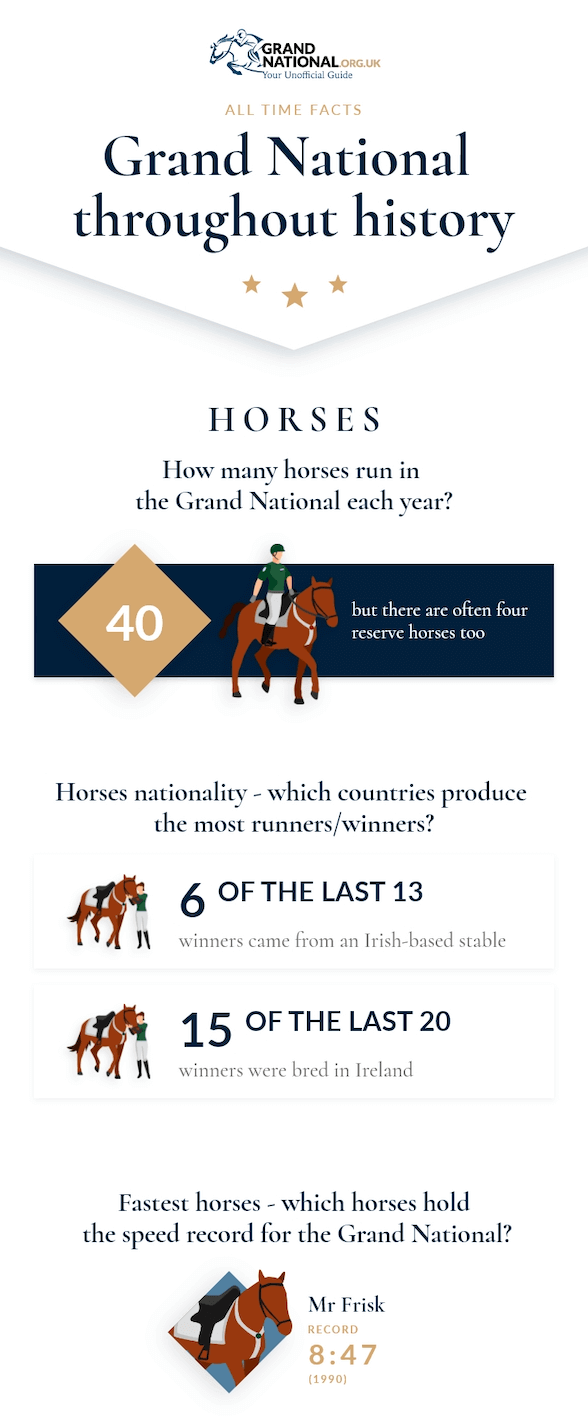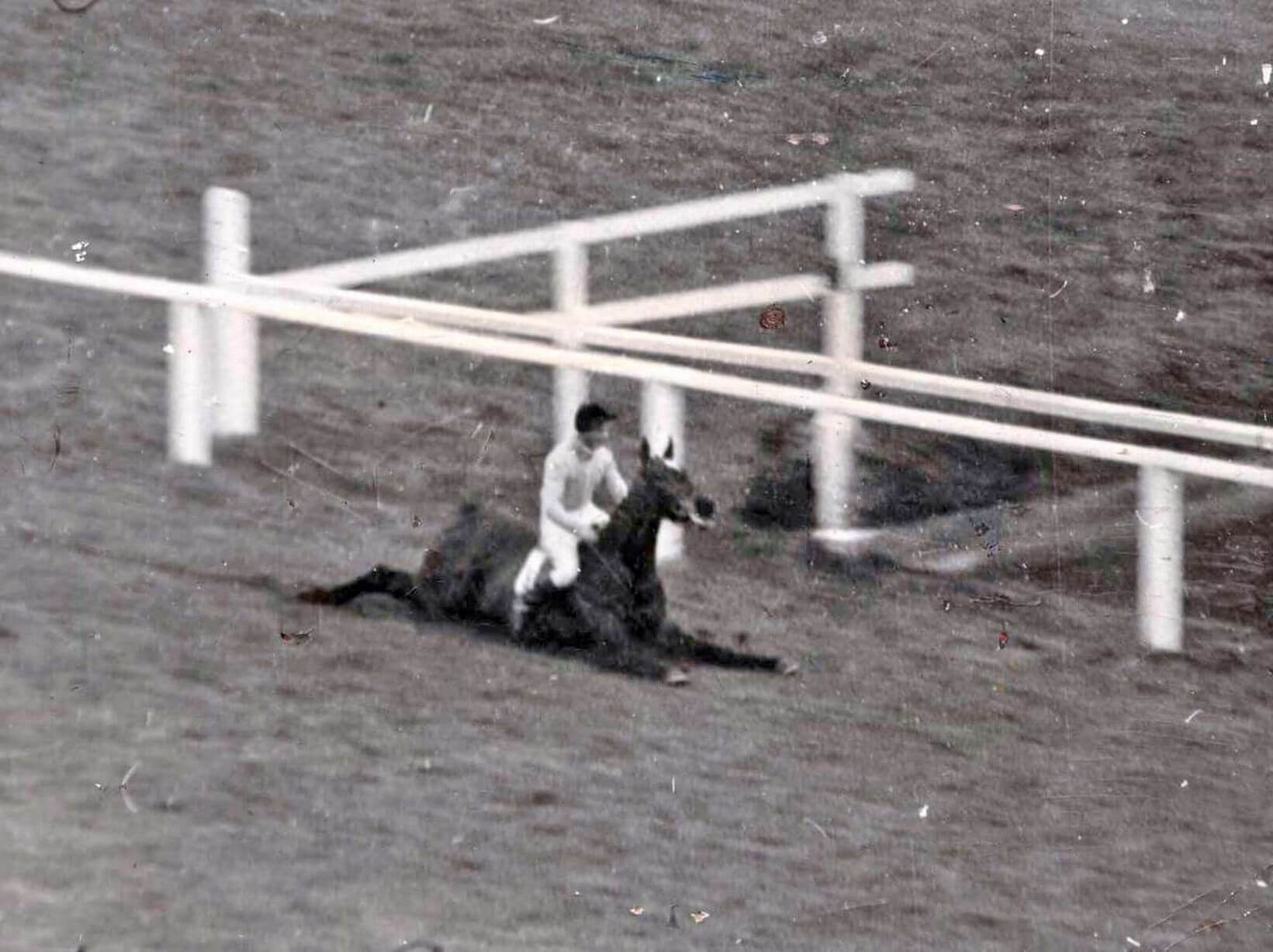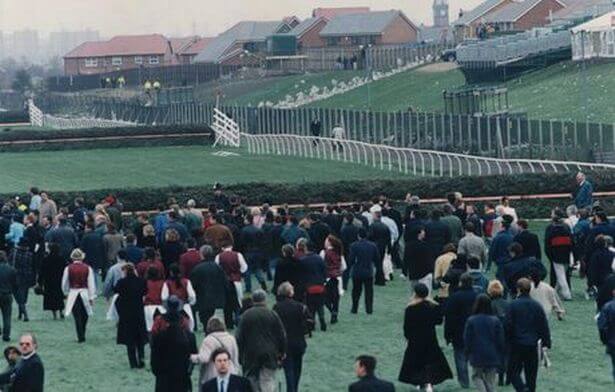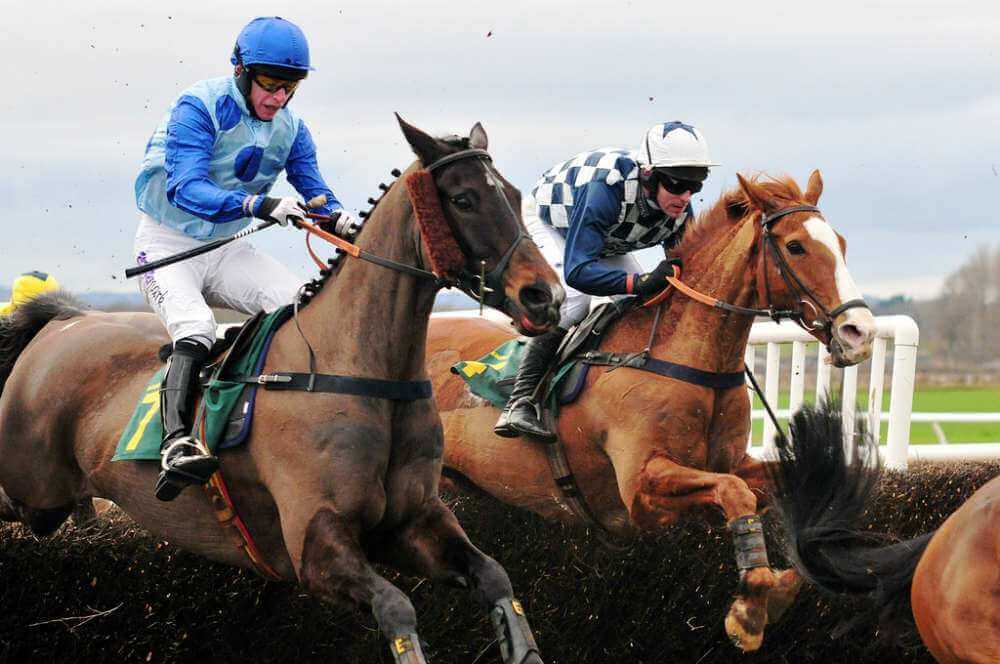Grand National History
The Grand National at Aintree has been a British sporting institution since 1839. Read about the legends and key moments that have gone down in Grand National history, and improve your knowledge of the Grand National by discovering the race’s storied history.
The course was founded by William Lynn, a syndicate head and proprietor of the Waterloo Hotel. He leased land in Aintree from William Molyneux, 2nd Earl of Sefton. Lynn set out a course and built a grandstand. Lord Sefton laid the foundation stone on 7 February 1829. The race was then known as the Grand Liverpool Steeplechase.
A horse called Lottery won the inaugural race and Captain Becher fell at a now world-famous brook. In those days, horses jumped a stone wall, crossed ploughed land and finished over two hurdles.
Grand National History
Grand National History has made the likes of Red Rum, Aldaniti, Jenny Pitman and Ginger McCain household names. Whilst fences such as Becher’s Brook, The Chair and the Canal Turn are equally familiar.
Click to enlarge

 Given the race’s long history, it is no surprise that many milestones have been reached and remarkable stories have unfolded. For example, no horse has run in the Grand National more times than Manifesto. He competed in eight Grand Nationals between 1895 and 1904, winning in 1897 and 1899. He finished third on three other occasions.
Given the race’s long history, it is no surprise that many milestones have been reached and remarkable stories have unfolded. For example, no horse has run in the Grand National more times than Manifesto. He competed in eight Grand Nationals between 1895 and 1904, winning in 1897 and 1899. He finished third on three other occasions.
The Aintree Grand National was first run in 1839. Bruce Hobbs, aged 17, was the youngest winning jockey in 1939, on Battleship, the smallest horse ever to win.
Dick Saunders, aged 48, was the oldest successful rider on Grittar in 1982. It was his first and only Grand National ride, after which he retired.
Jenny Pitman was the first woman to train a Grand National winner. She captured the race for the first time with Corbiere in 1983 and again with Royal Athlete in 1995. While in 2009, Venetia Williams became the second woman to saddle a National winner. She won with Mon Mome (11 years after she had actually ridden in the race). More recently both Sue Smith (Auroras Encore 2013) and Lucinda Russell (One For Arthur 2017) have trained Grand National winners.
Plenty of the race’s most fascinating stories revolve around its fearsome obstacles. The least number of horses to complete the race is two, in 1928: Tipperary Tim and Billy Barton (who remounted). In 2001, Red Marauder beat Smarty where only four of the forty horses completed, with two having to be remounted.
Early Grand National History
There is actually much debate regarding the first official Grand National. Some leading historians, including John Pinfold, assert that the first running was in 1836 and won by The Duke. This same horse won again in 1837, while Sir William was the winner in 1838. These races have long been disregarded because of the belief that they took place at Maghull and not Aintree.
Some historians have unearthed evidence that suggests those three races were run over the same course at Aintree. Also, that they were regarded as Grand Nationals up until the mid-1860. Contemporary newspaper reports place all the 1836-38 races at Aintree although the 1839 race is the first described as “National”. To date, though, calls for the Nationals of 1836–1838 to be restored to the record books have been unsuccessful.
In 1838 and 1839 three events transformed the Liverpool race from a small local affair to a national event. Firstly, the Great St. Albans Chase was not renewed after 1838. This left a major hole in the chasing calendar. Secondly, the railway arrived in Liverpool, enabling transport to the course by rail. Finally, a committee was formed to better organise the event.
These factors led to a highly publicised race in 1839. It attracted a larger field of top horses and riders, greater press coverage and increased attendance. Over time, the first three runnings were forgotten, securing 1839 its place in Grand National history as the inaugural race.
By the 1840s, Lynn’s ill-health blunted his enthusiasm for Aintree. Edward Topham, a respected handicapper and member of Lynn’s syndicate, began to exert his influence. He turned the chase into a handicap from a weight-for-age race in 1843. He took over the lease in 1848 and one century later, the Topham family bought the course outright.
Grand National History – Red Rum
It was over 40 years ago that Red Rum recorded the first of three victories in Grand National History. This earned him pride of place in the record books forever. He remains the only horse to have won three Grand Nationals and, was known to be a phenomenon.
Bred to be a sprinter, Red Rum won the gruelling four-and-a-half mile chase in 1973, 1974 and 1977. He finished second on his other two starts, to become the greatest Grand National performer ever. This was achieved after overcoming the bone disease pedalosteitis, which should have rendered him unraceable. However, fate stepped in: Red Rum was at the only yard where the training took place on a beach. Trainer Donald ‘Ginger’ McCain ran Red Rum into the seawater after viewing the hobbling horse, to work an amazing transformation.
Red Rum 1973
On 31 March 1973, he started 9/1 favourite for his first Grand National. However, by the time the runners had reached the Chair, the finish seemed inevitable. The Australian chaser, Crisp, shouldering top weight of 12st (now forbidden), built up a lead with four fences left. But, conceding 23lb to Red Rum, his stamina started to wane and he began to falter at the famous Elbow. After being more than 15 lengths in front of his rival, Red Rum gradually wore Crisp down. He beat Crisp by three-quarters of a length in a then-record time of 9 min 1.9 sec. It knocked nearly 20 seconds off Golden Miller’s previous best under 12st 2lb in 1934.
 Photo found on Liverpool Echo.
Photo found on Liverpool Echo.
Devon Loch spread-eagled on the run-in at the 1956 Grand National
Foinavon
Foinavon won the 1967 National in some of the most bizarre circumstances in Grand National history. At the smallest fence on the second circuit, the riderless Popham Down cut across the course causing a pile-up that almost brought the entire field to a standstill. John Buckingham, Foinavon’s jockey, was able to steer his mount wide of the melee and won on the 100/1 outsider.
The Aintree executive named the fence in honour of the horse – fence 7/ 23 (depending on the circuit). It’s 4ft 6in, one of the smallest jumps on the course, and situated between Becher’s Brook and the Canal Turn. This so-called no-hoper had taken part in some top class races before attempting the Grand National, finishing fourth in a King George and running a Gold Cup at Cheltenham, so perhaps his odds of 100/1 may have been a bit generous (although the Tote SP was 444/1). His owner was so unenthusiastic about his chances that he didn’t go to Aintree for the race.
Buckingham said that he didn’t realise that they were the only pair to jump the fence at the first attempt but he kept going. Although 17 horses remounted and finished the race the distance Foinavon had “stolen” at the obstacle meant that he led over the final seven fences to go on to collect his prize, 15 lengths clear of the fast-closing favourite, Honey End, and Red Alligator, who went on to win in 1968.
Foinavon also ran the following year’s Grand National but fell at the water jump. Foinavon was at one time owned by Anne, Duchess of Westminster, whose colours were also carried by the much superior Arkle. She also owned Last Suspect who won the 1985 Grand National.
Watch the 1967 Grand National, courtesy of British Pathé:
‘Most Exciting Grand National Ever! (1967)‘ uploaded by Sporting History to Youtube on 5/10/11
Michael O’Hehir
The commentary of Michael O’Hehir of the carnage at the 23rd fence ranks among the most famous in Grand National history and of BBC televised sport. It is often shown when BBC Sport puts together nostalgic montages of great sporting moments. O’Hehir received particular respect from his peers for the speed and unflustered coolness with which he identified Foinavon as the horse emerging from the mêlée. He later said in an interview that it was precisely the unfamiliarity of Foinavon’s colours that made him so instantly recognisable during the race.
O’Hehir visited the weighing room before the race, as is the custom of many National commentators, to familiarise himself more clearly with the colours of the silks but found himself completely stumped when looking at the black with red and yellow braces being worn by John Buckingham. Eventually, O’Hehir had to ask Buckingham who his mount was. A confused O’Hehir said that his racecard showed two-tone green quarters, as worn by the rider in the Cheltenham Gold Cup a few weeks earlier, but Buckingham explained that the owner felt green to be unlucky and so had registered new colours for the National.
The “Iron” Duke of Alburquerque
Beltrán Alfonso Osorio y Díez de Rivera, known as the “Iron” Duke of Albuquerque (1918-1994), surely ranks as the worst jockey in Grand National history. After receiving a film of the Grand National as a gift for his eighth birthday, the Duke became obsessed with it: “I said then that I would win that race one day,” he later recalled. He nearly died trying.
This magnificently barking mad Spanish aristocrat and amateur jockey entered the Grand National seven times with impressively consistent results. Generally, he would start with the others, gallop briefly and then wake up in the Royal Liverpool Infirmary (where apparently he always booked a private room when he rode in the race). Each year, Sir Peter O’Sullevan would gravely intone: “And the Duke of Albuquerque’s gone”.
On his first attempt in 1952, he fell from his horse at the sixth fence, nearly broke his neck and woke up later in hospital with a cracked vertebra. His next try was in 1963, when he fell from his horse yet again, this time at the fourth fence. Undeterred, he returned in 1965 but again fell from his horse after it collapsed underneath him, breaking his leg.
His ineptitude was so apparent that in 1963 bookies even offered odds of 66/1 – against him even finishing the race atop his horse!
He returned in 1973 when his stirrup broke, although he clung on for eight fences before being sent into inevitable orbit.
The Iron Duke’s Career End
In 1974, after having sixteen screws removed from a leg he had broken after falling in another race, he also fell while training for the Grand National and broke his collarbone. Nevertheless, he then competed in a plaster cast, this time actually managing to finish the race for the only time in his splendid career, but only in eighth (and last) place aboard Nereo: “I sat like a sack of potatoes and gave the horse no help” he said after the race.
One anecdote from this race is that he barged into Ron Barry at the second Canal Turn; Barry said “What the f*** are you doing?” to which he replied: “My dear chap I haven’t a clue…I’ve never got this far before!”
In 1976, he sustained his most serious injuries after being trampled in a race by several other horses. He suffered seven broken ribs, several fractured vertebrae, a broken wrist and thigh, and a major concussion, and was in a coma for two days. After recovering he announced, at the age of 57, that he planned to race yet again. Race organisers wisely revoked his license “for his own safety”.
Though the Iron Duke never won the Grand National, he certainly broke more bones than any other jockey in attempting to do so.
Notable Dates In Grand National History
Grand National History 1800s – 1930s
1837: THE DUKE wins the first Great Liverpool Steeplechase at Maghull, three miles from Aintree.
1839: Aintree becomes the new home for the event, with LOTTERY winning the prize and Captain Martin Becher crawling into the famous brook after a fall.
1847: MATTHEW records the first Irish-trained victory the day the race is officially named the Grand National.
1887: GAMECOCK wins the National at 20-1 wins the Champion Chase the next day.
1897: MANIFESTO, the 6-1 favourite, records the first of his two wins. He ran eight times up to the age of 16, also finishing third three times and fourth once.
1907: Jockey Alf Newey brings EREMON home in front, despite riding without stirrups from the second fence.
1927: Ted Leader rides SPRIG to a popular victory in the first Grand National to be covered by a BBC radio commentary.
1928: On race day, TIPPERARY TIM’S jockey William Dutton heard a friend call: “Billy boy, you’ll only win if all the others fall down!”. This turned out to be true, as 41 of the 42 starters fell during the race. As the field approached the Canal Turn, Easter Hero fell, causing a pile-up from which only seven horses emerged with jockeys. By the penultimate fence, this number had reduced to three. Great Span’s saddle slipped, leaving Billy Barton in the lead until he too then fell. This remains a record for the fewest number of finishers in Grand National history.
1934: The legendary GOLDEN MILLER becomes the only horse ever to win the Grand National and the Cheltenham Gold Cup in the same season, carrying 12st 2lb in record time.
Grand National History 1940s-1980s
1947: CAUGHOO beats 56 opponents at a mist-shrouded Aintree and is then accused of only going around once.
1956: DEVON LOCH and jockey Dick Francis, looking certain to give The Queen Mother victory when clear on the run-in, suddenly sprawl flat on the ground yards from the winning post, allowing ESB to win.
1967: The year of the horrific pile-up at the 23rd. John Buckingham and complete outsider FOINAVON avoid the melee and gallop on to a 100-1 win.
1974: Grand National character the Duke of Alburquerque completes the course for the one and only time in numerous attempts on NEREO, despite breaking his collarbone only a week before the race.
1977: The incomparable RED RUM rewrites the record books with his historic third victory. ‘Rummy’ had five runs, with three wins and two seconds, from the age of eight to 12.
1979: RUBSTIC makes history by becoming the first Scottish-trained winner. His homecoming party was heralded by a piper leading him back to the hamlet of Denholm, Roxburghshire.
1981: ALDANITI, nursed back from career-threatening injury three times, wins a fairytale National ridden by Bob Champion, who fought, and beat, cancer.
1982: Dick Saunders, at the age of 48, becomes the oldest winning jockey on GRITTAR. Geraldine Rees becomes the first woman to complete the course, riding the leg-weary CHEERS.
1983: Years of doubt about the Grand National’s future are ended when the Jockey Club, helped by public donations, buys the course. CORBIERE’s victory ensures Jenny Pitman goes into the history books as the first woman to train the winner.
1987: Jim Joel becomes the oldest winning owner at 92. He is on his way back from South Africa when MAORI VENTURE wins a thrilling race from The Tsarevich.
Grand National History – 1990s
1993: The darkest day in the history of the National. There is chaos after a second false start as 30 out of the 39 jockeys began the race despite a false start being called. John White passes the post first on the Jenny Pitman-trained ESHA NESS, only to discover the race has been declared void.
‘BBC News 3rd April 1993 Grand National declared void‘ uploaded by Phillip Reed to Youtube on 10/10/09
1993 Grand National History – the race that never was. Racing commentator Sir Peter O’Sullevan described it as “the greatest disaster in the history of the Grand National.”
1994: MIINNEHOMA, owned by comedian Freddie Starr, gives multiple champion trainer Martin Pipe his first National victory, and 51-year-old grandmother Rosemary Henderson completes the course on her own horse FIDDLERS PIKE, who finishes fifth.
1995: Jenny Pitman, the first lady of Aintree, gains her second success – two years after her first – with ROYAL ATHLETE.
1997: The National was postponed after two coded bomb threats were received from the IRA. The course was secured by police who evacuated jockeys, race personnel, and local residents along with 60,000 spectators. The race was eventually run 48 hours later on Monday, with the meeting organisers offering 20,000 tickets with free admission. The rearranged race was won by 14/1 shot LORD GYLLENE.

Photo found on Liverpool Echo.
Grand National History – A mass evacuation of Aintree racecourse took place on Saturday 5 April 1997
1999: Father-and-son trainer-jockey team Tommy and Paul Carberry combine to land a first Irish win for 24 years with BOBBYJO.
Grand National History – 2000s
2000: Ted and 20-year-old Ruby Walsh emulate the feat of their compatriots 12 months previously as PAPILLON lands a gamble, backed from a morning 33-1 into 10-1 before taking the prize.
2001: RED MARAUDER and Smarty are the only horses to put in clear rounds in a race run in atrocious conditions, though all horses return unscathed.
2003: MONTY’S PASS lands a massive gamble, with owner Mike Fuller netting close to £1million from ante-post bets. The horse is backed from 40-1 into 16-1 and romps home.
2004: Ginger McCain, veteran trainer of Red Rum, enjoys an emotional victory as 12-year-old AMBERLEIGH HOUSE lands the spoils, having been third in 2003.
2005: HEDGEHUNTER becomes the first horse since Corbiere in 1983 to carry more than 11st to victory in the great race, romping clear in great style under Ruby Walsh to slam Royal Auclair by 14 lengths. John Smith’s take over from Martell as the main sponsor.
2006: John Smith’s launched the John Smith’s People’s Race which gave ten members of the public the chance to ride in a flat race at Aintree on Grand National day. In total, thirty members of the public took part in the event before it was discontinued in 2010.
2008: COMPLY OR DIE allows David Pipe to join his legendary father, Martin, in the record books as a National-winning trainer in just his second season. The race also carries record prize money of £800,000.
2009: MON MOME becomes the biggest-priced winner since Foinavon when powering home at 100-1 for trainer Venetia Williams and jockey Liam Treadwell, who was having his first ride in the race.
Grand National History – 2010s
2010: DON’T PUSH IT, trained by Jonjo O’Neill and owned by JP McManus, provided champion jockey Tony McCoy with his first success on the 15th attempt. McCoy then won the BBC Sports Personality of the Year Award.
2011: An emotional victory for BALLABRIGGS’ on a sweltering day at Aintree. Donald McCain joined his father, Ginger, who trained Red Rum and Amberleigh House, in the Grand National record books.
2012: One of the closest finishes in the race’s illustrious history sees NEPTUNE COLLOGNES giving Paul Nicholls his first Grand National success. Katie Walsh achieves the highest finishing position by a female jockey; third place on Seabass, trained by her father Ted.
2013: Legendary showjumper Harvey Smith and his wife Sue send out 66-1 AURORAS ENCORE to cause a shock. Only two of the forty runners fell on the first circuit. Evan Williams places for the fifth time in five years.
2014: Part-time trainer, Dr Richard Newland, landed the first ever £1 million renewal of the race, courtesy of PINEAU DE RE. William’s amazing run continued with Alvarado fourth for the Welsh handler.
2015: Incredibly, another place for Williams with Alvarado fourth again behind MANY CLOUDS, who made a mockery of the trends as an eight-year-old carrying 11st 9lbs to land another victory in the race for Trevor Hemmings in Grand National History.
2016: Aptly named RULE THE WORLD came out on top on the very heavy ground. Young jockey, David Mullins and his mount smashed the longstanding trend that novices never win.
2017: ONE FOR ARTHUR became the first horse trained in Scotland since Rubstic in 1979. It would prove the first of two Grand National wins for Lucinda Russell.
2018: TIGER ROLL – Gave his trainer Gordon Elliott his second win in the race and became the Gigginstown House Stud’s second winner in three seasons. This popular horse that has won many races at the Cheltenham Festival was still only 8 when winning his first National.
2019: TIGER ROLL – Rewrote the history books to become the first horse since Red Rum (73 & 74) to win back-to-back Grand Nationals. Like he’d done the previous season, he won the Cross-Country race at the Cheltenham Festival the month before heading to Aintree. He was sent off as the well-backed 4/1 favourite for the 2019 Grand National and didn’t let his supporters down. In the process, he provided jockey – Davy Russell – with his second win in the Grand National.
Recent Grand National History
2020: The running of the 2020 Grand National was cancelled over health concerns. With the Grand National run each year in early April, the UK had shut down all horse racing during this month so the Aintree officials had no choice to call off the race.
2021: After a year off, the Grand National returned to bring us another moment of history, courtesy of MINELLA TIMES and Rachael Blackmore. She became the first female jockey to win the famous race, and duly followed it up by winning the Cheltenham Gold Cup on A Plus Tard in 2022.
2022: Crowds returned to Aintree to witness NOBLE YEATS‘ victory over Any Second Now. He became the first 7 year old to win the marathon race since 1940, surprising punters and bookmakers alike at odds of 50/1. The win also gave Sam Waley-Cohen a fairytale ending to his amateur riding career.
2023: CORACH RAMBLER justified his position as the pre-race favourite to win at odds of 8/1. His win was the second time Lucinda Russell and Derek Fox have successfully combined to win the famous race, after One For Arthur in 2017.
2024: Various safety measures were introduced, including a reduced field of just 32 runners, as I AM MAXIMUS saw off the challenges of Delta Work and Minella Indo to become the second favourite in a row to win the Grand National.
You might also like…
[wp-review id=”16″]








